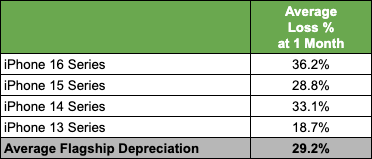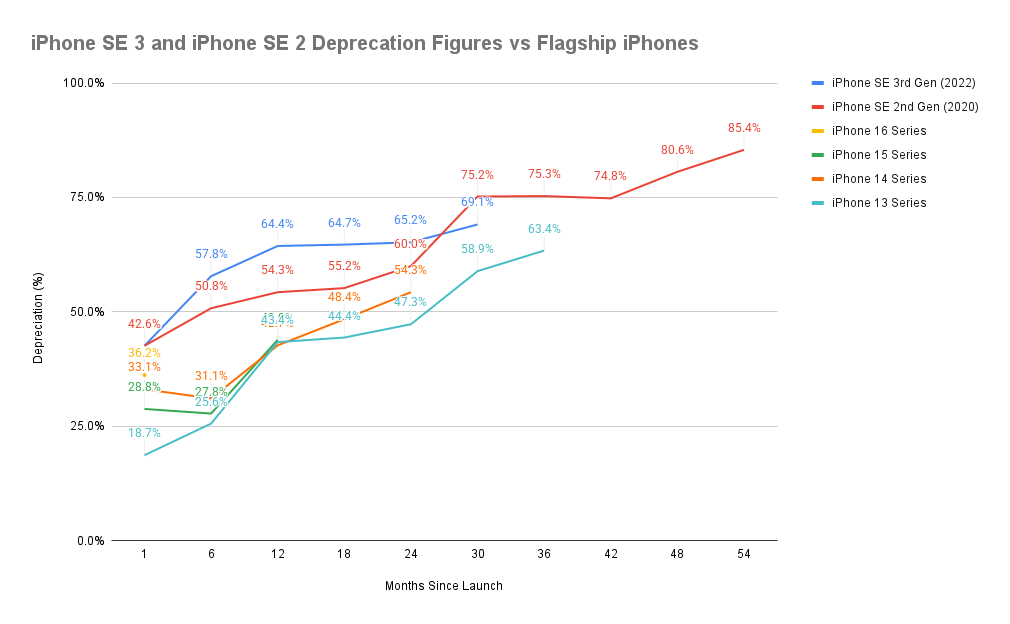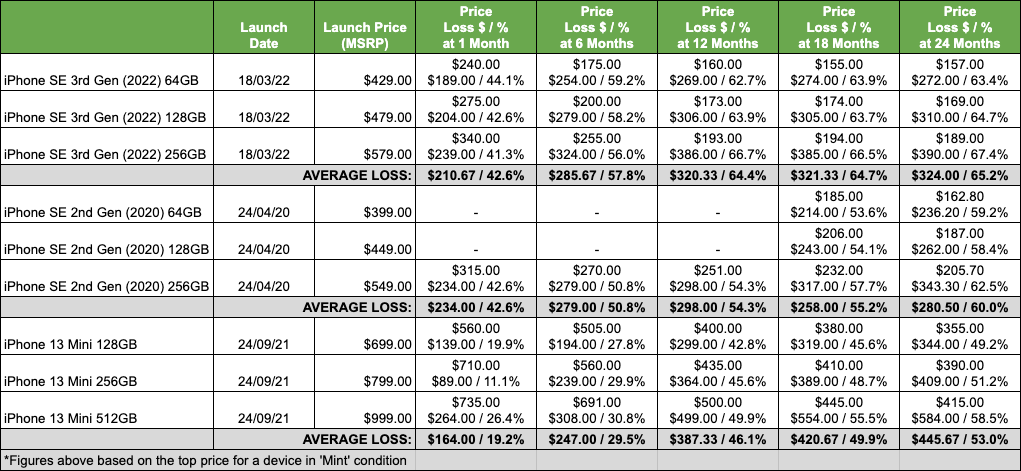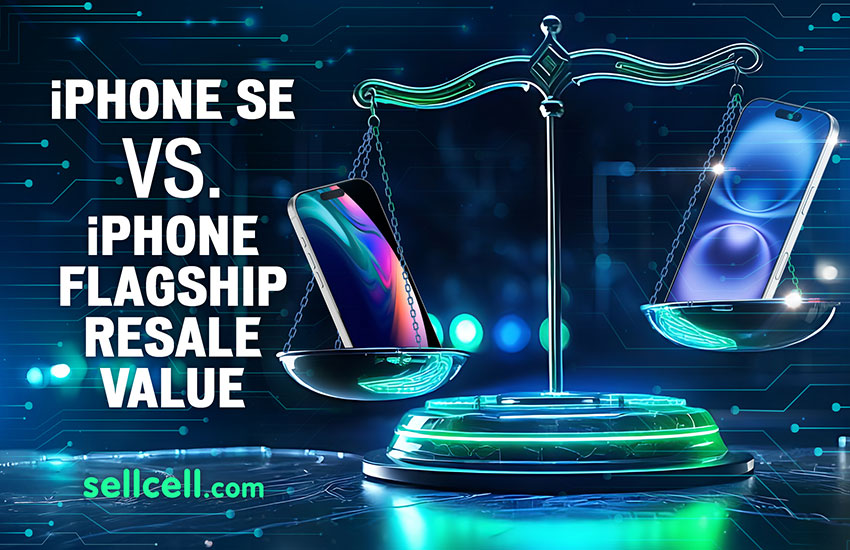Last updated February 21, 2025
iPhone SE models lose nearly half their value in the first month after launch – depreciating 1.5 times faster than flagship iPhones
Apple’s new iPhone SE 4 is expected to launch very soon, possibly this week, and will likely be a big hit for budget-conscious buyers. But there’s a catch—it’s also one of the fastest-depreciating recent iPhones.
Our latest data reveals just how much previous SE models lost in record time—and why SE 4 owners would need to act fast if they plan to resell or trade in.
For years, the iPhone SE lineup has offered Apple fans a way to get premium performance at a lower price. But that affordability comes with a hidden cost: higher depreciation compared to flagship iPhones.
So, before you rush to upgrade, here’s what you need to know about how quickly SE models lose value—and what you can do to protect your investment.
iPhone SE vs Flagships: Which Depreciates Faster?
Interestingly, not all compact iPhones experience such drastic value loss. The iPhone 13 Mini, for example, held its value far better—suggesting that depreciation isn’t just about size, but also about positioning and demand. More on that later.
Our latest depreciation analysis shows just how quickly SE models lose their worth compared to premium iPhones. Take a look at these numbers:
- The iPhone SE 3rd Gen (2022) series on average lost 42.6% of its value in just one month and a ($210 loss in value)—a massive drop
- Even worse, by six months, its value had dropped by 57.8%
- Compare this to the iPhone 15 series, which only lost 28.8% in one month and 27.8% after six months—a much slower rate of depreciation
- The trend continues with older models: The iPhone SE 2nd Gen (2020) saw a 50.8% drop by six months, whereas the iPhone 14 Series was only down 31.1%
This means that while the SE is a cheaper phone upfront, it doesn’t hold its value as well as premium iPhones.
Depreciation Summary Chart

Deeper Look at Long-Term Depreciation
Our data reveals that SE models experience fast depreciation after the first year post launch. By 18 months, SE models have lost up to 66.5% of their original value. On the other hand flagship models maintain better resale value than SE’s. Some of the key data points include:
- iPhone SE models lose nearly half their value in just one month, depreciating almost 1.5x faster than flagship iPhone’s.
- On average, flagship models lost 29.2% in the first month, while SE models lost 42.6%. The SE range depreciates almost 1.5 times faster than the flagships ranges in the first month post launch.

- The iPhone SE 3rd Gen (2022) 128GB lost 42.6% in just one month and 64.7% in 24 months.
- The iPhone SE 2nd Gen (2020) 64GB had lost 53.6% in 18 months, increasing to 76.9% by 30 months.
- While some SE models exceed 60% depreciation within 18 months, iPhone 15 and 14 models retain significantly more value, with the iPhone 14 losing 48.4% over 18 months and the iPhone 13 series 44.4% at 18 months.
- The SE will continue to depreciate quickly when a new phone is on the horizon. Indeed, with the last iPhone SE 3 launch, the SE 2 lost another 4% in the 12 weeks around the launch and nearly $20 off an already low residual value. This highlights that around a launch, selling as soon as possible remains key to minimizing value loss.
- The worst depreciating iPhone SE is the iPhone SE 2nd Gen (2020) 64GB, which after 30 months is only worth $92 and has depreciated by a whopping 76.9% and $307 of its once $399 list price.


Do All Apple’s Compact iPhones Depreciate the Same Way?
While iPhone SE models are one of the fastest recent depreciating iPhones, this hasn’t necessarily been the case for all compact phones. The iPhone 13 Mini, despite being a smaller device, actually held its value really well for a smaller well priced budget device.
- The iPhone 13 Mini lost only 19.2% in one month, compared to 42.6% for the iPhone SE 3rd Gen.
- At the 12 month mark, the Mini had only lost 46.1%, whereas the SE 3rd Gen had depreciated by 64.4%.
- Even at 24 months, the iPhone 13 Mini had lost only 53%, which was a similar rate of depreciation as other Flagship models.
The Mini’s rate of depreciation actually suggests that it isn’t necessarily the size of the phone that creates a lower value at resale. The original retail point clearly plays a big role and also the perception of features and design vs other iPhones are fundamental. Maybe even the name SE now has connotations of ‘budget’ that the rest of the range does not have. These are all things that Apple will be thinking about in launching a new device.


Could the iPhone SE 4 Depreciate Slower?
While past SE models have depreciated quickly, Apple could take some steps to improve resale value with the SE 4 by looking at how to integrate some more updated features. Factors that could slow depreciation may include:
- A Fresher Design – If Apple updates the SE 4 with some of the design features available in the rest of the iPhone 16 series (such as an iPhone 14-style body), it could retain value better than previous SE models.
- Upgraded Specs – Integrating the new A18 chip, face ID and enhanced storage with a better camera system may make it more aligned with flagship models which could boost long-term demand.
- Support for Apple Intelligence – the support for Apple Intelligence could help this new phone hold it’s value a lot better than predecessors
What Should SE Fans Do When it Comes to Trading in?
Budget-conscious Apple fans have faced a tough decision when it comes to buying a new phone as the new iPhone SE has been delayed and is out of the normal two-year upgrade cycle. Additionally, with the discontinuation of the iPhone Mini, there are fewer compact and affordable options in Apple’s lineup. This has left many unsure whether to wait for the SE 4 or switch to an older flagship.
If you do choose the iPhone SE 4, here are some tips to ensure that you get the best return when you come to upgrade:
- Trade It In Early – Selling an iPhone SE within the first year will get you the best return before depreciation accelerates.
- Check Trade-In Values on a regular basis – Don’t wait too long, as SE models see steeper drops than flagships. Also keeping an eye on predicted values of newly launched phones could be invaluable with a Smartphone Depreciation Calculator Tool
- Consider Certified Refurbished Flagships – If you’re price-sensitive but want a phone that holds value, a previous-gen flagship is worth looking at.
Conclusions
For Apple fans that are looking for a more affordable device an iPhone SE could be the device for them. If users are interested in achieving a good resale price when they look to upgrade their device, buying an SE may be a red flag for them in terms of the rapid value that can be lost in relatively short periods of time. The iPhone 13 Mini does however prove that compact and lower-value phones can hold their value. If Apple succeeds in producing a budget-friendly phone with more advanced features, it could change the depreciation trend—making the SE 4 a much stronger contender in the long run.
Methodology
The data in this article is based on SellCell reviewing the resale prices of 40 of the leading phone & tech buyback businesses in the US. SellCell have taken the top trade-in prices for selected devices in Mint condition and where they are unlocked. No personal data was used or stored as part of this process.
